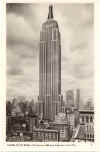 |
New York Architecture Images- Midtown
Empire State Building
Landmark |
|
architect |
Shreve, Lamb & Harmon, William F. Lamb as chief designer (&Gregory Johnson) |
|
location |
350 Fifth Ave., bet. W33 and W34 |
|
date |
1930-1931 |
|
style |
Art Deco |
|
construction |
Steel frame 102 floors, 1252
feet, 381 meters high. Effective use of setbacks to emphasize tower. The building is clad in Indiana limestone and granite, with the mullions lined in shiny aluminium. There are in all 6,500 windows, with spandrels sandblasted to blend their tone to that of the windows, visually creating the vertical striping on the facade. The windows and spandrels are also flush with the limestone facing, an aesthetic and economic decision. |
|
type |
Office Building |
| Click here for an Empire State Building gallery | |
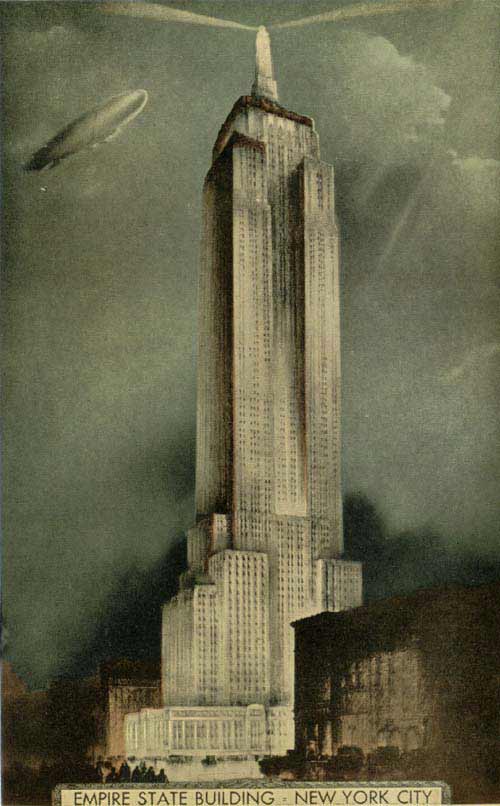  |
|
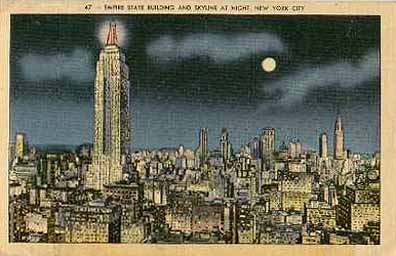 |
|
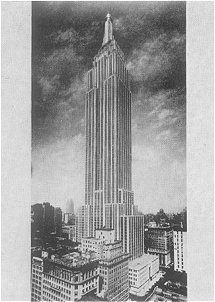 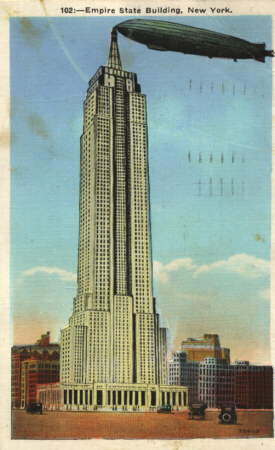 |
|
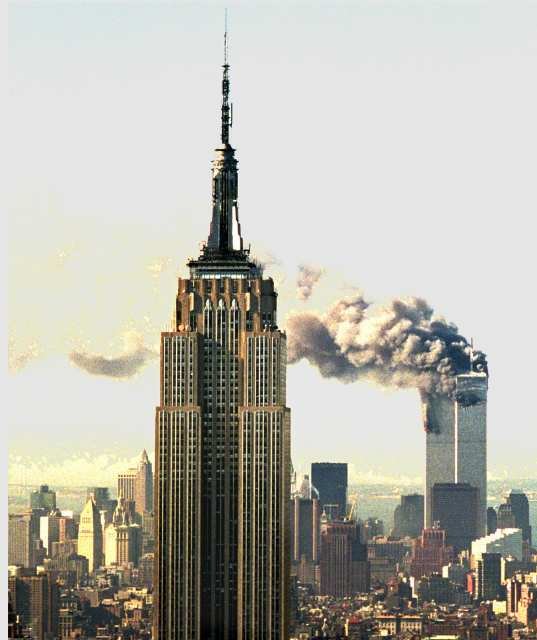 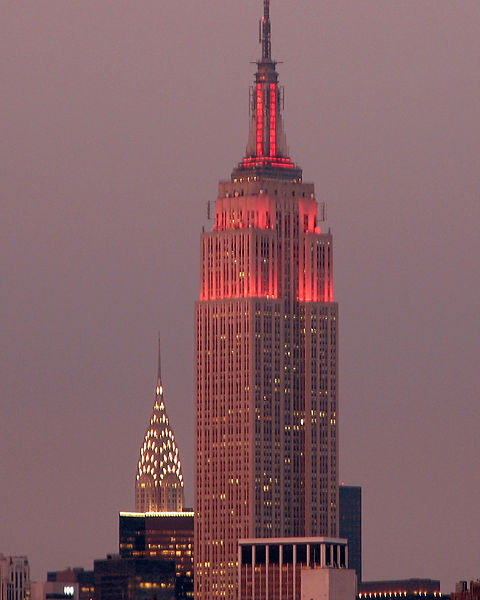 |
|
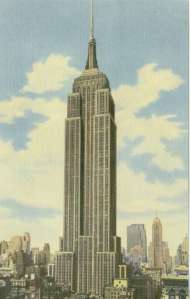 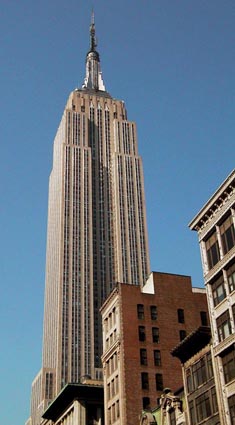 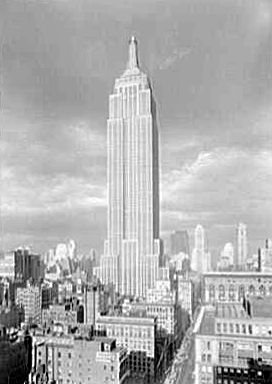 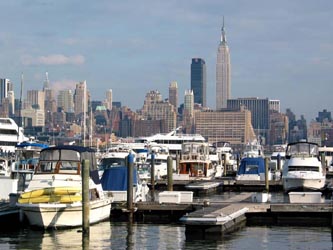 |
|
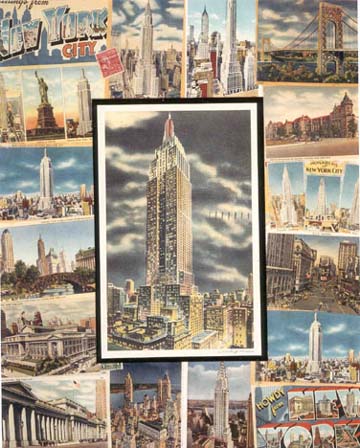 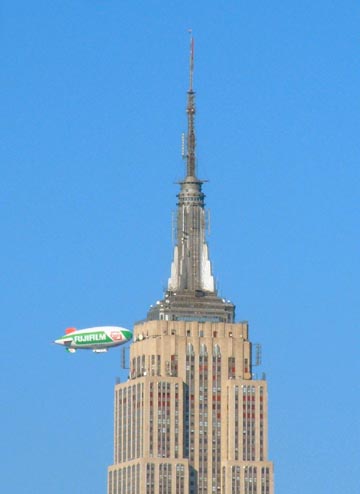 |
|
 |
|
 |
|
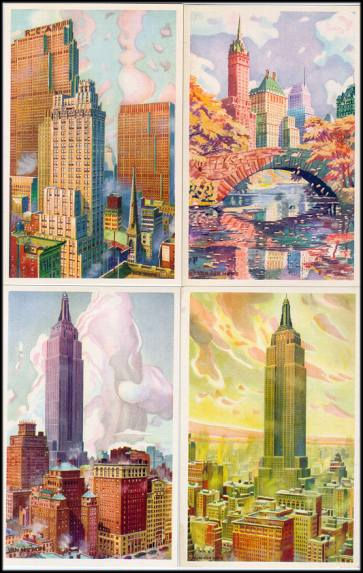 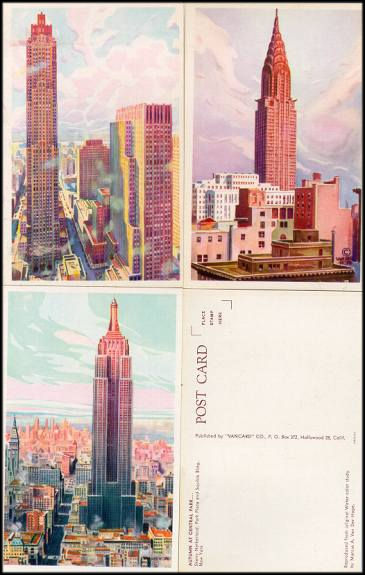 |
|
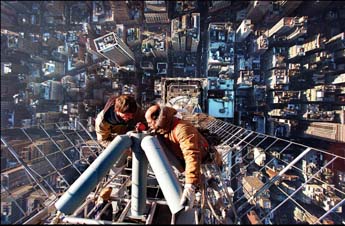 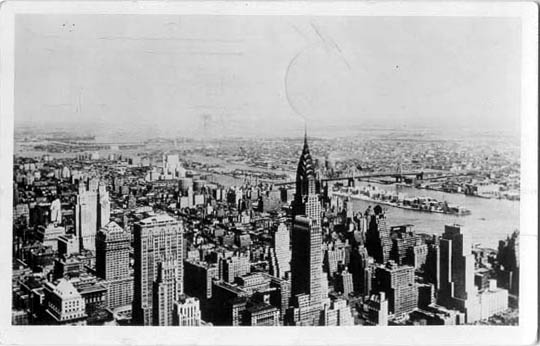 |
|
|
|
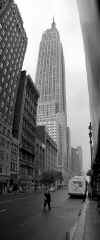 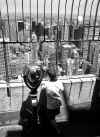 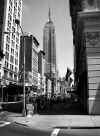 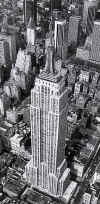 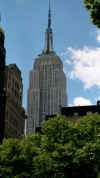 |
|
images |
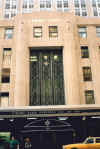 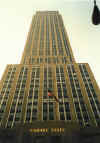 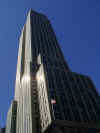  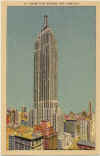 |
     |
|
     |
|
|
|
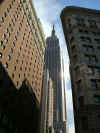 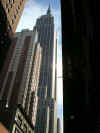 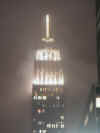  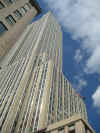 |
   |
|
|
interior |
     |
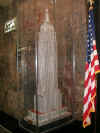      |
|
      |
|
      |
|
|
Standing in lonely dignity in the midriff of
Manhattan, a sentinel by land, a reassuring landmark by air, the Empire
State Building is the quadri-faced pharos of the city. And until
outstripped by the twin towers of the World Trade Center (1975), its 102
floors were the highest in New York. Though designed at the end of the
so-called Art Deco period in the 1920s, when zigzagged appliques were
prominent, its exterior shows little of the frippery characteristic of
that 'decorated' period. It is, moreover, one of the very few
skyscrapers with four facades, not just one facing the avenue.
"Zoning required several setbacks, but these were given a skillful buildup of scale at the lower levels, while the tower itself rises unflinchingly. Indented setbacks in the center of each of the long sides help lateral scale. An observation platform and a pylon topped by a television transmission antenna crown all." — from G.E. Kidder Smith. Looking at Architecture. p152. "The architectural, commercial, and popular success of the Empire State Building depended on a highly rationalized process, and equally efficient advertising and construction campaigns. Skillful designers of Manhattan office buildings, architects Shreve, Lamb, and Harmon were familiar with the imperatives of design and construction efficiency that maximized investors' returns by filling the building with tenants as soon as possible. ... "The Empire State Building, like most art deco skyscrapers, was modernistic, not modernist. It was deliberately less pure, more flamboyant and populist than European theory allowed. It appeared to be a sculpted or modeled mass, giving to business imagery a substantial character..." — Edward W. Wolner, in International Dictionary of Architects and Architecture, Randall J. Van Vynckt, editor. Volume 2, p963-964. Details 102 floors The epitome of big buildings, billed as the
Eighth Wonder of the World at its opening, the Empire State Building
broke records in many categories, including height (1250 feet) and
construction time (it took only one year and forty-five days to build). |
|
|
Bibliography
Irwin Clavan. "The Empire State Building, IX. The Mooring Mast", Architectural Forum. February 1931. Volume 54 Number 2. p229. drawing of artist's conception of the activities to be carried on in the mooring mast, p231. Howard Davis. Slide from photographer's collection. PCD.2260.1012.1702.050. PCD.2260.1012.1702.049. PCD.2260.1012.1702.048. PCD.2260.1012.1702.047 Sir Banister Fletcher. Sir Banister Fletcher's A History of Architecture. 18th ed., revised by J.C. Palmes. New York: Charles Scribner's Sons, 1975. ISBN 684-14207-4. NA200.F63. photo, p1224. — The classic text of architectural history. Mitchell Pacelle. Empire: A Tale of Obsession, Betrayal, and the Battle for an American Icon. John Wiley & Sons, 2001. — G. E. Kidder Smith. Looking at Architecture. New York: Harry N. Abrams, Publishers, 1990. ISBN 0-8109-3556-2. LC 90-30728. NA200.S57 1990. discussion, p152. twilight overview photo, p153. Henry C. Meyer, Jr. "The Empire State Building, IV. Heating and Ventilating", Architectural Forum. October 1930. Vol 53 Number 4. p517. drawing of transverse section, p519. Toshino Nakamura, ed. "Empire State Building, 1931", A+U Extra Edition. April 1987. p129. drawing of exterior wall detail, p132. color drawing of exterior perspective, p6. R. H. Shreeve. "The Economic Design of Office Buildings", Architectural Record. April 1930. Vol 67 Number 4. p341. drawing of exterior perspective, p340. drawing of floors 6-20 plan, p339. drawing of floors 30, 32, 40 and 43 plan, p339. drawing of floor 66 and 67 plan, p339. |
|
|
The Empire State Building is a 102-story Art Deco skyscraper in New York
City, New York at the intersection of Fifth Avenue and West 34th Street.
Its name is derived from the nickname for the state of New York. It
stood as the world's tallest building for more than forty years, from
its completion in 1931 until construction of the World Trade Center's
North Tower was completed in 1972. Following the destruction of the
World Trade Center in 2001, the Empire State Building became for the
second time, the tallest building in New York City. The Empire State Building has been named by the American Society of Civil Engineers as one of the Seven Wonders of the Modern World. The building and its street floor interior are designated landmarks of the New York City Landmarks Preservation Commission, and confirmed by the New York City Board of Estimate.[5] It was designated as a National Historic Landmark in 1986.[3][6][7] In 2007, it was ranked number one on the List of America's Favorite Architecture according to the AIA. The building is owned by Harold Helmsley's company and managed by its management/leasing division Helmsley-Spear. History of the building The present site of the Empire State Building was first developed as the John Thomson Farm in the late 18th century. The block was occupied by the Waldorf-Astoria Hotel in the late 19th century, and was frequented by The Four Hundred, the social elite of New York. Design and Construction The Empire State Building was designed by Gregory Johnson and his architectural firm Shreve, Lamb and Harmon, which produced the building drawings in just two weeks, possibly using its earlier design for the R.J. Reynolds Tower in Winston-Salem, North Carolina as a basis.[8] The building was actually designed from the top down.[9] The general contractors were Starrett Brothers and Eken, and the project was financed by John J. Raskob. The construction company was chaired by Alfred E. Smith, a former Governor of New York.[2] Excavation of the site began on January 22, 1930, and construction on the building itself started symbolically on March 17—St.Patrick's Day—per Al Smith's influence as Empire State, Inc. president. The project involved 3,400 workers, mostly immigrants from Europe, along with hundreds of Mohawk iron workers. According to official accounts, five workers died during the construction.[10] Governor Smith's grandchildren cut the ribbon on March 1st, 1931. The construction was part of an intense competition in New York for the title of the world's tallest building. Two other projects fighting for the title, 40 Wall Street and the Chrysler Building, were still under construction when work began on the Empire State Building. Both would hold the title for less than a year, as the Empire State Building had surpassed them upon its completion, just 410 days after construction commenced. The building was officially opened on May 1, 1931 in dramatic fashion, when United States President Herbert Hoover turned on the building's lights with the push of a button from Washington, D.C. Ironically, the first use of tower lights atop the Empire State Building, the following year, was for the purpose of signalling the victory of Franklin D. Roosevelt over Hoover in the presidential election of November 1932.[11] Empty State Building The building's opening coincided with the Great Depression in the United States, and as a result much of its office space went unrented. In its first year of operation, the observation deck took in over a million dollars, as much money as its owners made in rent that year. The lack of renters led New Yorkers to deride the building as the "Empty State Building".[12] The building would not become profitable until 1950. The famous 1951 sale of The Empire State Building to Roger L. Stevens and his business partners was brokered by the prominent lower Manhattan real estate firm Charles F. Noyes & Company for a record $51 million. At the time, that was the highest price ever paid for a single structure in real estate history.[13] Dirigible Terminal The building's distinctive art deco spire was originally designed to be a mooring mast and depot for dirigibles. The 102nd floor was originally a landing platform with a dirigible gangplank. A particular elevator, traveling between the 86th and 102nd floors, was supposed to transport passengers after they checked in at the observation deck on the 86th floor.[2] However, the idea proved to be impractical and dangerous after a few attempts with airships, due to the powerful updrafts caused by the size of the building itself. The T-shaped mooring devices remain in place. A large broadcast antenna was added to the top of the spire in 1952. 1945 Plane Crash At 9:40 a.m. on Saturday July 28, 1945, a B-25 Mitchell bomber, piloted by Lieutenant Colonel William F. Smith, Jr., who was flying in a thick fog, accidentally crashed into the north side of the Empire State Building between the 79th and 80th floors, where the offices of the National Catholic Welfare Council were located. One engine shot through the side opposite the impact and another plummeted down an elevator shaft. The fire was extinguished in 40 minutes. Fourteen people were killed in the incident.[14][15] Elevator operator Betty Lou Oliver survived a plunge of 75 stories inside an elevator, which still stands as the Guinness World Record for the longest survived elevator fall recorded.[16] Despite the damage and loss of life, the building was open for business on many floors the following Monday. Tallest Skyscraper for 41 years The Empire State Building remained the tallest skyscraper in the world for a record 41 years, and stood as the world's tallest man-made structure for 23 years. It was surpassed by the North Tower of the World Trade Center in 1972, and the Sears Tower shortly afterwards. With the destruction of the World Trade Center in the September 11, 2001 attacks, the Empire State Building again became the tallest building in New York City, and the second-tallest building in the United States. Suicides Over the years, more than thirty people have committed suicide from atop the building.[17] The fence around the observatory terrace was put up in 1947 after five people tried to jump during a three-week span.[18] In 1979, Elvita Adams jumped from the 86th floor, only to be blown back onto the 85th floor and left with only a broken hip.[19] The building was also the site of suicides in 2004 and 2006. Most recently a lawyer committed suicide by leaping from the 69th floor on Friday, April 13, 2007.[20] Features Architectural The Empire State Building rises to 1,250 feet (381.0 m) at the 102nd floor, and including the 203 foot pinnacle, its full height reaches 1,453 feet and 8 9/16th inches (443 m). The building has 85 stories of commercial and office space (2,158,000 sq ft/200,000 m) and an indoor and outdoor observation deck on the 86th floor. The remaining 16 stories represent the art deco tower, which is capped by a 102nd floor observatory. Atop the tower is the 203 foot pinnacle, much of which is covered by broadcast antennas, with a lightning rod at the very top. The Empire State Building is the first building to have more than 100 floors. It also has over 100 bathrooms (lavatories). Empire State Building on a rainy July afternoonThe Empire State Building has 6,500 windows and 73 elevators. There are 1,860 steps from street level to the 102nd floor. It has a total floor area of approximately 2,768,591 square feet (257,000 m²). The base of the Empire State Building is about 2 acres (0.8 ha). The building houses 1,000 businesses, and has its own zip code. As of 2007, approximately 20,000 employees work in the building each day, making the Empire State Building the second largest single office complex in America, after the Pentagon. The building was completed in one year and 45 days. Its original sixty-four elevators are located in a central core. Today, the Empire State Building has 73 elevators in all, including service elevators. It takes less than one minute by elevator to get to the 86th floor, where an observation deck is located. The building has 70 miles (113 km) of pipe and 2,500,000 feet (760,000 m) of electrical wire.[21] The building is heated by low pressure steam. Despite its height, the building only requires between two and three pounds per square inch (0.14 to 0.21 kg. per cm²) of steam pressure for heating. The building weighs approximately 370,000 short tons (336,000 M/T). The Empire State Building cost $40,948,900 to build. Unlike most of today's high-rise buildings, the Empire State Building features a classic façade. The modernistic stainless steel canopies of the entrances on 33rd and 34th Streets lead to two story-high corridors around the elevator core, crossed by stainless steel and glass-enclosed bridges at the second floor level. The elevator core contains 67 elevators.[5] The lobby is three stories high and features an aluminum relief of the skyscraper without the antenna, which was not added to the spire until 1952. The north corridor contains eight illuminated panels, created by Roy Sparkia and Renée Nemorov in 1963, depicting the building as the Eighth Wonder of the World, alongside the traditional seven. Long-term forecasting of the life cycle of the structure was implemented at the design phase to ensure that the building's future intended uses were not restricted by the requirements of previous generations. This is particularly evident in the over-design of the building's electrical system.. Floodlights In 1964, floodlights were added to illuminate the top of the building at night, in colors chosen to match seasonal and other events, such as Christmas.[22] After the eightieth birthday and subsequent death of Frank Sinatra, for example, the building was bathed in blue light to represent the singer's nickname "Ol' Blue Eyes." After the death of actress Fay Wray (King Kong) in late 2004, the building stood in complete darkness for 15 minutes.[23] The floodlights bathed the building in red, white, and blue for several months after the destruction of the World Trade Center, then reverted to the standard schedule.[24] Traditionally, in addition to the standard schedule the building will be lit in the colors of New York's sports teams on the nights they have home games (orange, blue and white for the New York Knicks, red, white and blue for the New York Rangers, and so on). The building is illuminated in tennis ball yellow during the US Open tennis tournament in late August and early September. It was even lit scarlet red twice for Rutgers University, once for a football game on November 9, 2006, when they played the University of Louisville in what would result in the biggest win in university history, and again on April 3, 2007 when the women's basketball team played Tennessee in the national championship game.[25] In June 2002, during the Golden Jubilee of Her Majesty Queen Elizabeth II of the United Kingdom, New York City illuminated the Empire State Building in purple and gold (the monarchical colors of the Royal House of Windsor). New York City Mayor Michael Bloomberg said that it was a sign of saying thank you to HM The Queen for having the National Anthem of the United States played at Buckingham Palace after the September 11, 2001 attacks, as well as the support the United Kingdom provided afterwards. The building has also been known to be illuminated in purple and white in honor of graduating students from New York University. When the New York Mets beat the New York Yankees in the May 2007 Subway Series, the building was bathed in the winner's colors, orange and blue, the following night. The building was lit green for three days in honor of the Islamic holiday of Eid ul-Fitr in October 2007. The lighting, the first for a Muslim holiday, is intended to be an annual event.[26] Observation decks The Empire State Building has one of the most popular outdoor observatories in the world, having been visited by over 110 million people. The 86th floor observation deck offers impressive 360-degree views of the city. There is a second observation deck on the 102nd floor that is open to the public. It was closed in 1999, but reopened in November 2005. Completely enclosed and much smaller; it may be closed on high-traffic days. A panoramic view of New York City from the 86th floor observation deck of the Empire State Building, spring 2005 Broadcast stations New York City is the largest media market in the United States. Since the September 11, 2001 attacks, nearly all of the city's commercial broadcast stations (both television and FM radio) have transmitted from the top of the Empire State Building, although a few FM stations are located at the nearby Condé Nast Building. Most New York City AM stations broadcast from just across the river in New Jersey. Communications devices for broadcast stations are located at the top of the Empire State Building. Broadcasting began at Empire on December 22, 1931 when RCA began transmitting experimental television broadcasts from a small antenna erected atop the spire (no longer a space reserved for dirigibles, after being proven impractical). They leased the 85th floor and built a laboratory there, and—in 1934—RCA was joined by Edwin Howard Armstrong in a cooperative venture to test his FM system from the Empire antenna. When Armstrong and RCA fell out in 1935 and his FM equipment was removed, the 85th floor became the home of RCA's New York television operations, first as experimental station W2XBS channel 1, which eventually became (on July 1, 1941) commercial station WNBT, channel 1 (now WNBC-TV channel 4). NBC's FM station (WEAF-FM, now WQHT) began transmitting from the antenna in 1940. NBC retained exclusive use of the top of the Empire until 1950, when the FCC ordered the exclusive deal broken, based on consumer complaints that a common location was necessary for the (now) seven New York television stations to transmit from so that receiving antennas would not have to be constantly adjusted. Construction on a giant tower began. Other television broadcasters then joined RCA at Empire, on the 83rd, 82nd, and 81st floors, frequently bringing sister FM stations along for the ride. Multiple transmissions of TV and FM began from the new tower in 1951. In 1965, a separate set of FM antennas were constructed ringing the 102nd floor observation area. When the World Trade Center was being constructed, it caused serious problems for the television stations, most of which then moved to the World Trade Center as soon as it was completed. This made it possible to renovate the antenna structure and the transmitter facilities for the benefit of the FM stations remaining there, which were soon joined by other FMs and UHF TVs moving in from elsewhere in the metropolitan area. The destruction of the World Trade Center necessitated a great deal of shuffling of antennas and transmitter rooms in order to accommodate the stations moving back uptown. As of 2007, the Empire State Building is home to the following stations: TV: WCBS-TV 2, WNBC-TV 4, WNYW 5, WABC-TV 7, WWOR-TV 9 Secaucus, WPIX-TV 11, WNET 13 Newark, WNYE-TV 25, WXTV 41 Paterson, WNJU 47 Linden, and WFUT-TV 68 Newark FM: WXRK 92.3, WPAT-FM 93.1 Paterson, WNYC-FM 93.9, WPLJ 95.5, WQXR-FM 96.3, WQHT-FM 97.1, WSKQ-FM 97.9, WRKS-FM 98.7, WBAI 99.5, WHTZ 100.3 Newark, WCBS-FM 101.1, WQCD 101.9, WWFS 102.7, WKTU 103.5 Lake Success, WAXQ 104.3, WWPR-FM 105.1, WCAA 105.9 Newark, WLTW 106.7, and WBLS 107.5. Empire State Building Run-Up The Empire State Building Run-Up is a foot race from ground level to the 86th floor observation deck that has been held annually since 1978. Its participants are referred to both as runners and as climbers. The race covers a vertical distance of 1,050 ft (320m) and takes in 1,576 steps. The record time is 9 minutes and 33 seconds, achieved by Australian professional cyclist Paul Crake in 2003,[27][28] a climbing rate of 6,593 ft (2,010 m) per hour. In popular culture The Empire State Building is frequently depicted in many forms of popular culture, including films, television shows, video games, and fiction novels. Perhaps the most famous popular cultural representation of the building is in the 1933 film King Kong, in which the title character, a giant ape, climbs to the top to escape his captors. The observation deck is commonly used as a designated site for romantic rendezvous in films such as Love Affair, An Affair to Remember, Elf, and Sleepless In Seattle. Further reading The Empire State Building Book, by Jonathan Goldman, St. Martin's Press, 1980. Unbuilding, by David Macaulay, Houghton Mifflin, 1986. The Empire State Building - The making of a landmark, by John Tauranac, Scribner, 1995. Construction: Building the Impossible, by Nathan Aaseng, The Oliver Press, Inc., 2000. Empire: A Tale of Obsession, Betrayal, and the Battle for an American Icon, by Mitchell Pacelle, Wiley, 2002 Higher: A Historic Race to the Sky and the Making of a City, by Neal Bascomb, Doubleday, 2003 Building The Empire State, edited by Carol Willis, Norton, 1998. |
|
| links |
|